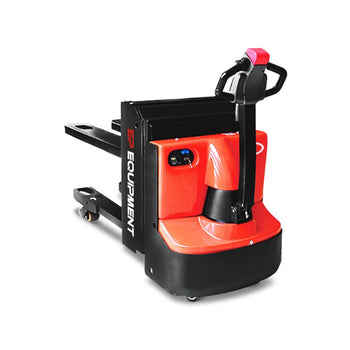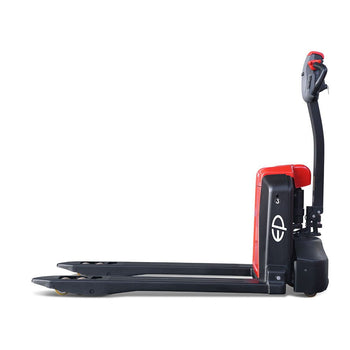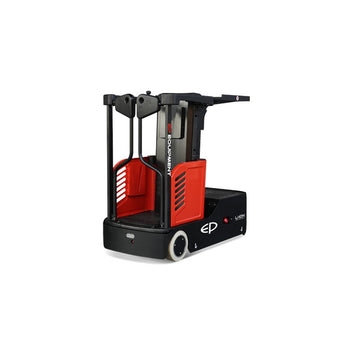Introduction: Powering a Better Workplace
Lithium-ion (Li-ion) technology has revolutionised portable electronics, and its impact is now profoundly transforming industrial and commercial environments. Li-ion batteries are increasingly powering heavy-duty equipment like electric forklifts, material handling machinery, automated guided vehicles (AGVs), autonomous mobile robots (AMRs), aerial lifts, and floor cleaning machines. This isn't just an incremental upgrade; it's a strategic evolution enhancing operational efficiency and sustainable practices across diverse sectors, from bustling material handling facilities to critical airport ground support.
The shift to Li-ion power is a significant investment in an organisation's most valuable asset: its human capital. This article will explore the often-underestimated advantages of Li-ion technology in directly enhancing employee safety, comfort, and overall well-being, fostering a more productive, engaged, and ultimately, happier workforce.
Elevating Workplace Safety with Lithium-Ion Technology
A. Reducing Chemical and Fire Hazards
Traditional lead-acid batteries, common in industrial equipment, pose significant chemical hazards. They require regular watering, which often leads to electrolyte loss, acid spills, and corrosion, demanding immediate cleanup and specialised procedures. During charging, lead-acid batteries emit hazardous gases like hydrogen, posing respiratory and explosion risks, necessitating dedicated, well-ventilated charging rooms that consume valuable space and add infrastructure costs.
In stark contrast, Li-ion batteries are sealed, maintenance-free units. They eliminate the need for watering, do not off-gas during normal operation, and completely remove the risk of corrosive acid spills. This fundamental difference eradicates a major source of chemical exposure and dramatically improves indoor air quality, particularly in enclosed environments like warehouses or food processing facilities. The absence of these daily chemical and ventilation concerns creates a noticeably healthier and safer working atmosphere.
While Li-ion batteries carry risks like thermal runaway under adverse conditions, modern industrial Li-ion solutions are engineered with sophisticated safety features. The integrated Battery Management System (BMS) continuously monitors and controls parameters like cell temperatures, current, and voltage, preventing common issues like overcharging and overheating. Many industrial Li-ion packs incorporate "safety by design" principles, including robust mechanical enclosures and innovative sub-pack configurations that use isolating and phase-change materials to halt the spread of thermal events. Integrated flame arrestors also prevent flames from escaping a compromised cell.
The nature of safety management changes with Li-ion. Lead-acid batteries present continuous, low-level chemical and ventilation hazards requiring ongoing manual mitigation. Li-ion technology, while having a higher severity risk if a thermal event occurs, significantly reduces the probability of daily, routine chemical exposure. This shifts the safety challenge from managing constant, diffuse chemical hazards to implementing robust, engineered controls for a less frequent but potentially more impactful event. For business owners, this means a more predictable and controllable safety environment, reducing the burden of daily manual hazard mitigation and potentially lowering the overall risk profile when proper systems and training are in place.
B. Minimising Physical Strain and Operational Risks
A notable advantage of Li-ion batteries is their significantly lighter weight and more compact size compared to equivalent lead-acid batteries. This weight reduction directly translates into lighter industrial equipment, making it more nimble and considerably easier for operators to manoeuvre. For employees, this directly mitigates physical strain, leading to fewer musculoskeletal issues and a noticeable decrease in fatigue, especially over extended work shifts. This is a direct ergonomic improvement, reducing risks associated with heavy lifting and repetitive motions.
Another critical distinction is consistent power delivery. Unlike lead-acid batteries, which experience a continuous voltage drop as their charge depletes, Li-ion batteries maintain a remarkably flat discharge curve, ensuring consistent power output throughout their operational cycle. This stable voltage guarantees that equipment performs reliably without unexpected slowdowns or sudden performance drops. Such consistency is paramount in preventing accidents, especially in precision-driven tasks where predictable equipment behavior is crucial for operator safety and minimizing errors. This reduces the cognitive burden on operators, allowing them to focus entirely on the task at hand rather than constantly adjusting for changes in machine performance, leading to fewer errors and a less stressful work environment.
Li-ion batteries are virtually maintenance-free, a stark contrast to lead-acid counterparts which require frequent watering, acid cleaning, and complex inspections. Importantly, Li-ion technology largely eradicates the need for hazardous battery swaps. In multi-shift operations, lead-acid batteries often require removal using specialized lifting equipment, transport to dedicated charging rooms - a process fraught with risks of injury, acid exposure, or equipment damage. With Li-ion, one battery can often power equipment for multiple shifts through opportunity charging, minimizing or even eliminating manual battery handling. This significantly reduces the risk of injuries directly associated with battery changes and handling.
Eliminating manual battery swaps and extensive maintenance removes a highly repetitive and hazardous task from daily operations, freeing up valuable labor and reducing congestion in battery charging areas. This shift can lead to a broader positive impact on workplace safety culture, fostering a culture of proactive safety rather than reactive hazard mitigation.

Boosting Comfort and Productivity for a Happier Workforce
A. Enhancing the Work Environment
The lighter weight of Li-ion batteries directly enhances ergonomics for equipment operators. Lighter equipment is easier to maneuver, requiring less physical effort. For forklifts, the higher power density of Li-ion allows for a smaller footprint, enabling more spacious and ergonomically optimised operator compartments. This design contributes significantly to all-day comfort, reducing physical fatigue and improving overall worker well-being.
While not entirely silent, Li-ion batteries contribute significantly to a quieter overall work environment. The absence of off-gassing eliminates the need for noisy, high-volume ventilation systems in charging rooms. Furthermore, when Li-ion powered electric equipment replaces traditional internal combustion (IC) trucks, the reduction in noise pollution is substantial, alongside the complete elimination of exhaust fumes and soot. A quieter and cleaner environment reduces stress, improves communication, and enhances overall comfort, fostering a more pleasant, less distracting, and ultimately more productive atmosphere. This comprehensive improvement in air quality and noise levels contributes to a higher quality of work life, leading to better concentration, reduced stress-related health issues, and a general feeling of well-being.
B. Driving Operational Efficiency
One of the most compelling operational advantages of Li-ion batteries is their significantly faster charging capability. Li-ion batteries typically achieve a full charge in just 1 to 4 hours, compared to 8 hours for lead-acid, which also require an additional 8-hour cool-down period. This rapid charging enables "opportunity charging," allowing equipment to be quickly topped up during short breaks or between shifts. This minimises downtime, ensuring equipment is almost continuously available for use. For multi-shift operations, a single Li-ion battery can often power a vehicle for 24 hours, eliminating the need for multiple batteries per vehicle and the associated labor and safety risks of frequent battery swapping.
Beyond rapid charging, Li-ion batteries offer extended run times and a significantly longer operational lifespan, often lasting two to four times longer than lead-acid batteries. This combination of longevity and consistent power delivery means fewer interruptions for battery changes or performance degradation during shifts, resulting in a smoother, more continuous workflow and higher throughput in material handling and other industrial operations. Minimising disruptive pauses reduces stress and frustration for operators, allowing them to maintain focus and rhythm, contributing to higher job satisfaction and a greater sense of accomplishment.
C. The Morale Multiplier
The tangible improvements in safety and comfort provided by Li-ion technology directly and positively impact employee morale, job satisfaction, and retention. When employees perceive that their employer genuinely values their health and safety, they are more likely to feel secure, develop stronger loyalty, and commit more deeply to the company. Feeling safe and comfortable reduces stress and anxiety, leading to increased job satisfaction. A workplace that prioritises safety fosters a deeper sense of belonging and builds trust, encouraging open communication and employee engagement. Companies recognised for prioritising workplace safety also build a positive reputation, attracting top talent and helping reduce costly employee turnover rates.
Investing in advanced technologies like Li-ion, which demonstrably improve both safety and comfort, sends a clear signal of a company's commitment to employee well-being. This commitment becomes a powerful differentiator in recruitment and retention efforts. Employees are more likely to choose and remain with an organisation that prioritises their physical and mental health, ultimately reducing costly turnover and fostering a more experienced, efficient, and stable workforce.
The Strategic Advantage: A Brief Cost-Benefit Analysis
While the initial capital investment for industrial Li-ion batteries can be higher than for traditional lead-acid batteries, a comprehensive long-term financial analysis reveals substantial benefits that often significantly outweigh these upfront costs. These savings accrue from various operational and human capital improvements:
-
Reduced Labor Costs: Eliminating time-consuming battery swaps, regular watering, and extensive maintenance procedures significantly reduces labor hours.
-
Lower Operational Costs: Li-ion batteries boast a lifecycle up to three times longer and are up to 50% more energy-efficient than lead-acid batteries, contributing to a 40% lower total cost of ownership over their lifespan. Their higher efficiency also translates directly into lower electricity bills.
-
Increased Productivity: Faster charging times, the flexibility of opportunity charging, and extended run times minimise equipment downtime, leading to higher equipment availability and increased throughput.
-
Reduced Healthcare Costs and Lost Workdays: A safer workplace directly results in fewer accidents and injuries, reducing workers' compensation claims and medical expenses. Improved employee well-being means fewer lost workdays due to injury, illness, or stress.
-
Lower Turnover Costs: Enhanced safety and comfort contribute significantly to higher employee retention rates, saving substantial costs associated with recruitment, hiring, and training new employees.
The direct cost savings (labor, energy, maintenance) are quantifiable. However, the indirect benefits related to human capital - fewer injuries, higher morale, lower employee turnover - create a powerful multiplier effect on financial performance. Fewer injuries mean lower insurance premiums and reduced workers' compensation claims. Higher morale and improved retention contribute to a more experienced, efficient, and engaged workforce, boosting productivity and reducing errors. Investing in Li-ion technology is not merely an operational upgrade but a strategic human resources decision that yields compounding financial returns, transforming a traditional cost center (safety and HR issues) into a value driver.

Conclusion: A Holistic Investment in Human Capital
The widespread adoption of advanced lithium-ion battery technology in industrial and commercial settings marks a pivotal shift towards creating inherently safer, more efficient, and significantly more comfortable workplaces. Beyond immediate operational gains, Li-ion technology systematically eliminates many long-standing chemical and physical hazards associated with lead-acid batteries. By mitigating fire risks through sophisticated management systems, eradicating noxious fumes and corrosive acid spills, and enabling lighter equipment that reduces physical strain, Li-ion directly contributes to a healthier and more secure environment for every employee.
Ultimately, investing in Li-ion batteries transcends a mere equipment upgrade; it represents a profound and strategic investment in an organization's most valuable asset: its people. Enhanced employee safety and comfort translate directly into higher job satisfaction, improved morale, and increased retention rates, fostering a more stable, productive, and engaged workforce. The long-term financial benefits—from reduced healthcare expenses and workers' compensation claims to increased productivity and lower turnover—underscore that this is not simply an expense, but a wise, sustainable investment in human capital and operational excellence. Embracing Li-ion technology is a clear and compelling pathway to cultivating a workplace where employees are not only safer but genuinely happier, driving sustained business success and fostering a culture of well-being.





